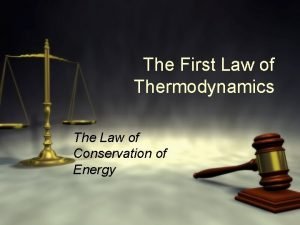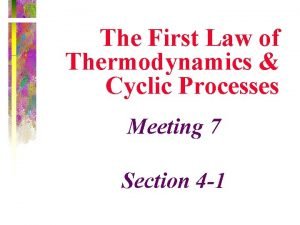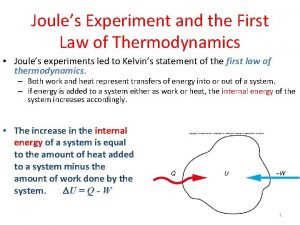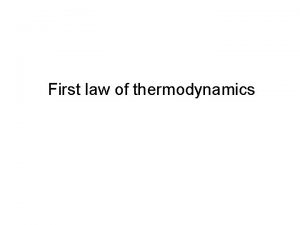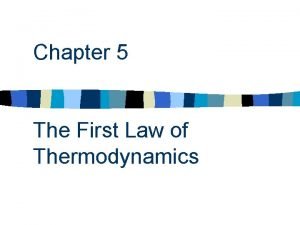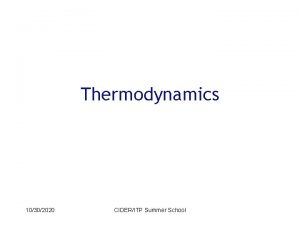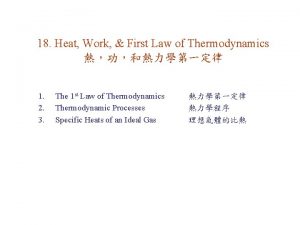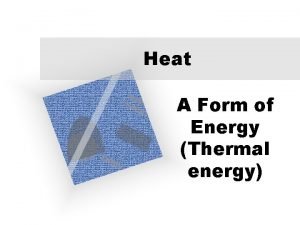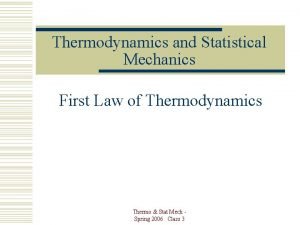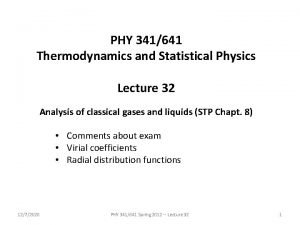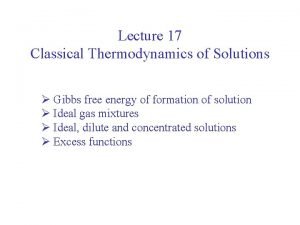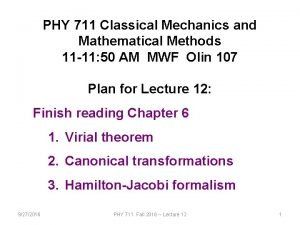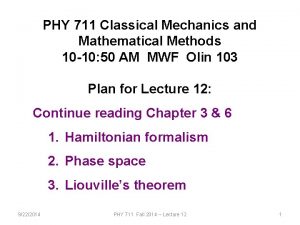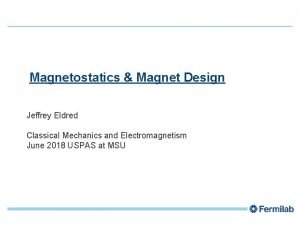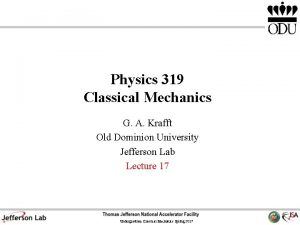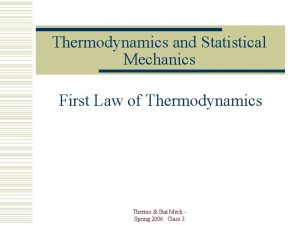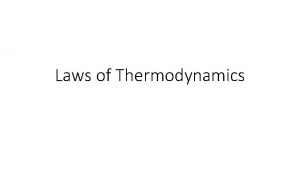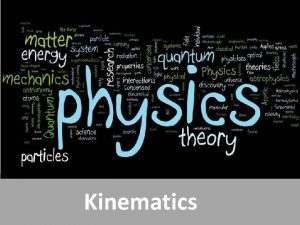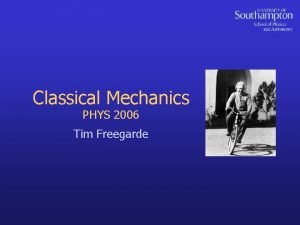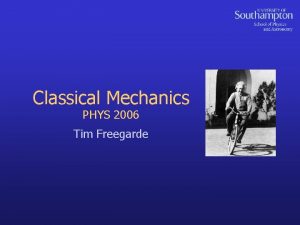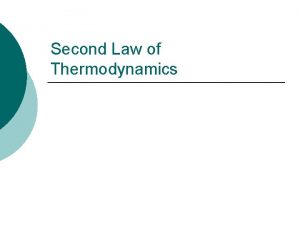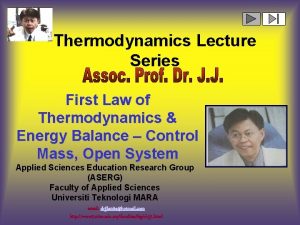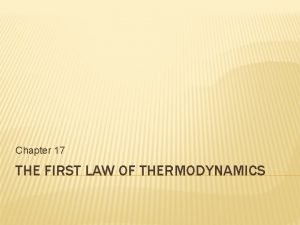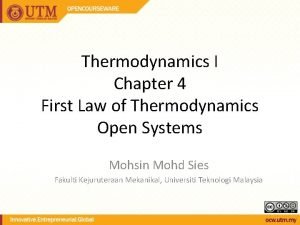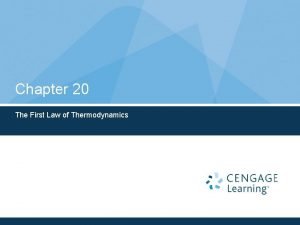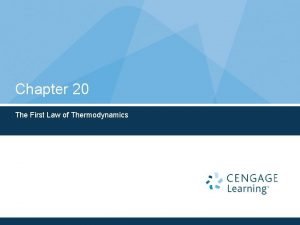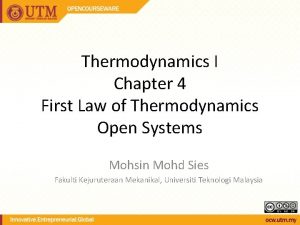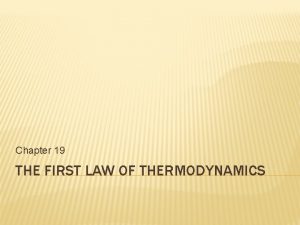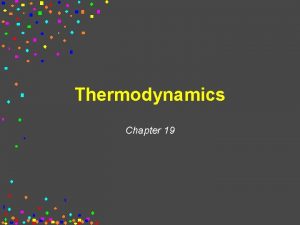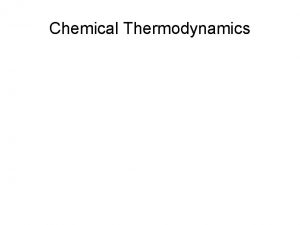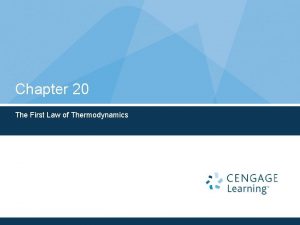First law of thermodynamics Thermal systems Classical mechanics






















- Slides: 22

First law of thermodynamics

Thermal systems Classical mechanics Thermal system • Thermal systems: - deals with many individual objects - conceptually different from mechanical systems - don’t know the position, velocity, and energy of any molecules or atoms or objects - can’t perform any calculation on them • Sacrifice microscopic knowledge of the system, using macroscopic parameters instead - volume (V) - temperature (T) - pressure (P) - number of particles (N) - energy (E), etc. • Macroscopic systems with many individual objects: - processes are often irreversible - arrow of time does exist - energy conservation is not enough to describe thermal states

Thermodynamic systems Isolated systems can exchange neither energy nor matter with the environment. reservoir Heat Work Closed systems exchange energy but not matter with the environment. Work Open systems can exchange both matter and energy with the environment.

Idea gas model Lattice model for solid state materials The ideal gas model • • • all the particles are identical the particles number N is huge the particles can be treated as point masses the particles do not interact with each other the particles obey Newton’s laws of motion, but their motion is random collisions between the particles are elastic The ideal gas equation of state: k. B = 1. 38 10 -23 J/K

Internal energy • The internal energy of a system of N particles, U, is all the energy of the system that is associated with its microscopic components when view from a reference frame at rest with respect to the object. • Internal energy includes: - kinetic energy of translation, rotation, and vibration of particles - potential energy within the particles - potential energy between particles For a non-ideal gas: For an ideal gas (no interactions): • Internal energy is a state function – it depends only on the values of macroparameters (the state of a system) Monatomic: Diatomic:

Heat and work are both defined to describe energy transfer across a system boundary. • Heat (Q): the transfer of energy across the boundary of a system due to a temperature difference between the system and its surroundings. - Q > 0: temperature increases; heating process - Q < 0: temperature decreases; cooling process (C: heat capacity) • Heat transfer mechanisms - conduction: exchange of kinetic energy between microscopic particles (molecules, atoms, and electrons) through collisions - convection: energy transfer by the movement of a heated substance such as air - radiation: energy transfer in the form of electromagnetic waves heat • Work (W): any other kind of energy transfer across boundary

Quasi-static processes Quasi-static (quasi-equilibrium) processes: • Sufficiently slow processes, and any intermediate state can be considered as at thermal equilibrium. The macro parameters are well-defined for all intermediate states. • The state of a system that participates in a quasiequilibrium process can be described with the same number of macro parameters as for a system in equilibrium. • Examples of quasi-static processes: - isothermal: T = constant - isovolumetric: V = constant - isobaric: P = constant - adiabatic: Q = 0

Work done during volume changes Quasi-static process at each infinitesimal movement Work done by the gas as its volume changes from Vi to Vf

Work done during volume changes (cont. ) • d. V > 0: the work done on the gas is negative • d. V < 0: the work done on the gas is positive In thermodynamics, positive work represents a transfer of energy out of the system, and negative work represents a transfer of energy into the system. P Pi The work done by a gas in the expansion is the area under the curve connecting the initial and final states i P-V diagram f Pf Vi Vf V

Work and heat are not state functions a c b a. isovolumetric b. isobaric a. isobaric b. isovolumetric isothermal • Because the work done by a system depends on the initial and final states and on the path followed by the systems between the states, it is not a state function. • Energy transfer by heat also depends on the initial, final, and intermediate states of the system, it is not a state function either.

• When heat enters a system, will it increase the system’s internal energy? • When work is done on a system, will it increase the system’s internal energy? It depends on the path!

The first law of thermodynamics • Two ways to exchange energy between a system and its surroundings (reservoir): heat and work • Such exchanges only modify the internal energy of the system • The first law of thermodynamics: conservation of energy reservoir Heat Work Q > 0: energy enters the system Q < 0: energy leaves the system W > 0: work done on the system is negative; energy leaves the system W < 0: work done on the system is positive; energy enters the system • For infinitesimal processes:

Several examples Isolated systems: Adiabatic processes Cyclic processes P i, f Insulating wall V initial state = final state The internal energy of an isolated systems remains constant Energy exchange between “heat” and “work” Expansion: U decreases Compression: U increases

Idea gas isovolumetric process Isovolumetric process: V = constant P 2 1 V 1, 2 (CV: heat capacity at constant volume) V reservoir Heat During an isovolumetric process, heat enters (leaves) the system and increases (decreases) the internal energy.

Idea gas isobaric process P Isobaric process: P = constant 2 1 V 2 V (CP: heat capacity at constant pressure) reservoir Heat Work During an isobaric expansion process, heat enters the system. Part of the heat is used by the system to do work on the environment; the rest of the heat is used to increase the internal energy.

Idea gas isothermal process P 1 Isothermal process: T = constant 2 V 1 V 2 V During an isothermal expansion process, heat enters the system and all of the heat is used by the system to do work on the environment. During an isothermal compression process, energy enters the system by the work done on the system, but all of the energy leaves the system at the same time as the heat is removed.

Idea gas adiabatic process P Adiabatic process: Q = 0 2 1 V 2 V 1 Idea gas: Adiabatic process: V

Idea gas adiabatic process P 2 1 V 2 V 1 let V , and divided by

Idea gas adiabatic process P 2 1 V 2 V 1 V For monatomic gas,

Idea gas adiabatic process P 2 1 V 2 V 1 V or

Idea gas adiabatic process P 2 1 V 2 V 1 V During an adiabatic expansion process, the reduction of the internal energy is used by the system to do work on the environment. During an adiabatic compression process, the environment does work on the system and increases the internal energy.

Summary • Internal energy, heat, and work: - internal energy is the energy of the system; a state function - heat and work are two ways to exchange energy between the system and the environment. They are not state functions and depend on the path • The first law of thermodynamics connects the internal energy with heat and work: Quasi-static process Character isovolumetric V = constant isobaric P = constant isothermal T = constant adiabatic
 Energy balance equation thermodynamics open system
Energy balance equation thermodynamics open system Isobaric process formula
Isobaric process formula 1th law of thermodynamics
1th law of thermodynamics First law of thermodynamics joule's experiment
First law of thermodynamics joule's experiment 1st law of thermodynamics
1st law of thermodynamics What is steady flow process in thermodynamics
What is steady flow process in thermodynamics First law of thermodynamics sign convention
First law of thermodynamics sign convention First law of thermodynamics control mass
First law of thermodynamics control mass Gibbs free energy
Gibbs free energy First law of thermodynamics for ideal gas
First law of thermodynamics for ideal gas Newton's first law and second law and third law
Newton's first law and second law and third law Newton's first law and second law and third law
Newton's first law and second law and third law Heat energy formula
Heat energy formula Dulong petit law
Dulong petit law Thermodynamics and statistical mechanics
Thermodynamics and statistical mechanics Classical thermodynamics
Classical thermodynamics Section 3 using thermal energy answers
Section 3 using thermal energy answers Thermal transfer vs direct thermal printing
Thermal transfer vs direct thermal printing Virial theorem in classical mechanics
Virial theorem in classical mechanics Virial theorem in classical mechanics
Virial theorem in classical mechanics Angular momentum in classical mechanics
Angular momentum in classical mechanics Classical mechanics
Classical mechanics Classical mechanics
Classical mechanics

